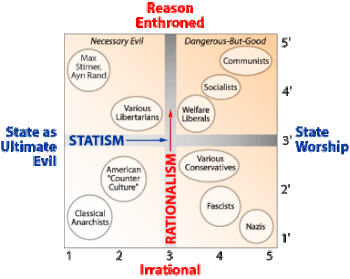Pournelle chart
This article includes alist of references,related reading,orexternal links,but its sources remain unclear because it lacksinline citations.(May 2018) |

ThePournelle chart,developed byJerry Pournellein his 1963 political science Ph.D. dissertation, is atwo-dimensional coordinate systemwhich can be used to distinguishpolitical ideologies.It is similar to thepolitical compassand theNolan Chartin that it is a two-dimensional chart, but the axes of the Pournelle chart are different from those of other systems. The two axes are as follows:
- The x-axis, "Attitude toward the State" (labeledstatism), refers to apolitical philosophy's attitude toward thestateandcentralized government.The farthest right is "state worship" and the farthest left represents the state as the "ultimate evil", preferringindividual freedom.
- The y-axis, "Attitude toward planned social progress" (labeledrationalism), refers to the extent which a political philosophy is compatible with the idea thatsocial problemscan be solved by the use ofreason.The top indicates complete confidence in plannedsocial progressand the bottom representsskepticismof such methods, often considering them as naivelyutopian.Those at the top of the axis would tend to discard a traditional custom if they do not understand what purpose it serves (considering it antiquated and probably useless), while those at the bottom would tend to keep the custom (considering it time-tested and probably useful).
Pournelle arrangedAmerican liberalism,socialism,andcommunism,in the upper right-hand quadrant of high state control and high rationalism.Conservatism,fascism,andNazismare placed in the lower right hand quadrant of high state control and low rationalism. Classicalanarchistsare in the lower left hand corner of low state control and low rationalism.Libertarians(includinganarcho-capitalists) andObjectivistsare placed in the upper left-hand corner of low state control and high rationalism. Each diagonal axis contains natural political allies.
See also
[edit]External links
[edit]- The Pournelle Political Axes.
- Ambidextrous Sovereigntyat theWayback Machine(archived 17 March 2008)
